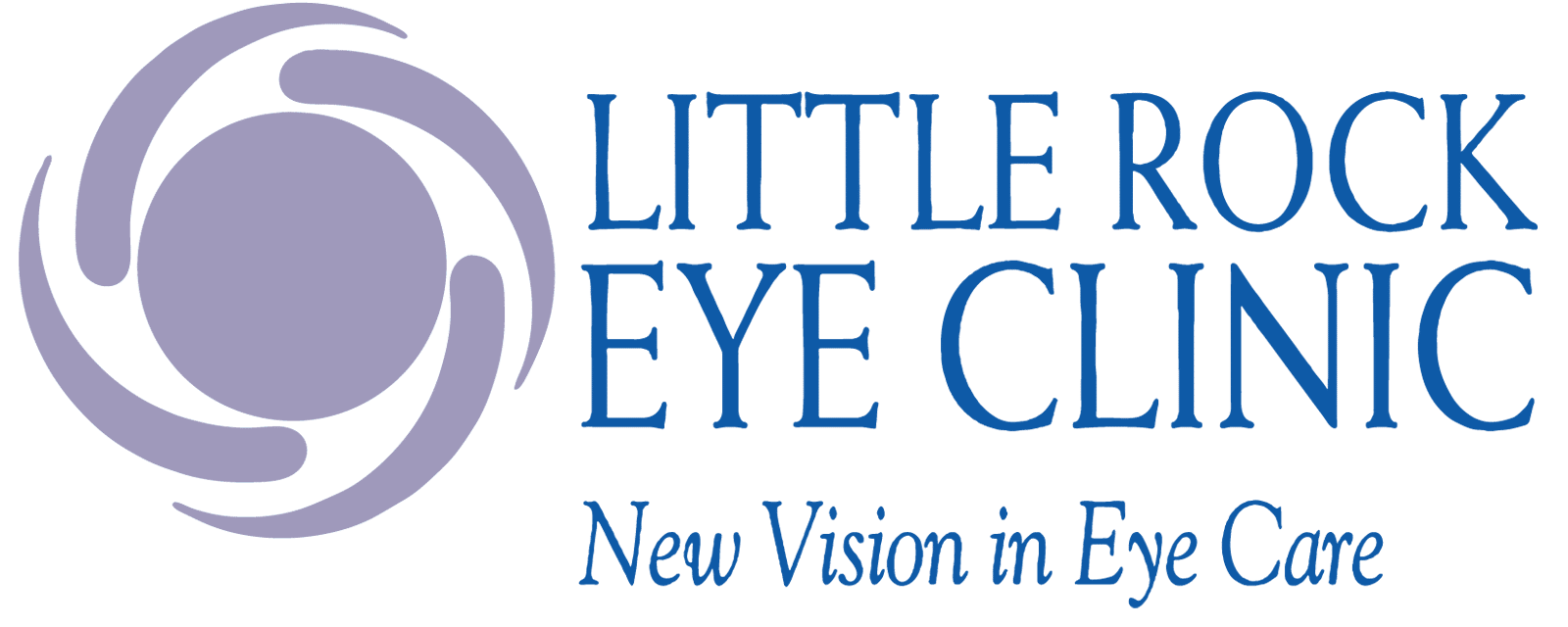To our patients and families:
It is the rare family that never has a member affected at some time by cataracts. We find that when faced with medical choices, a better informed person is able to make more appropriate decisions regarding the treatment of cataracts. We hope you find the following information valuable to your making a more informed decision.
—The Doctors of Little Rock Eye Clinic
Cataract FAQs
Q What is a cataract?
A Cataract is a cloudiness of the natural lens of the eye, a common but curable cause of vision loss. The human eye functions much like a camera. It has a front clear windshield (the cornea), an aperture to allow the appropriate amount of light in (the pupil or iris, colored part of the eye), a lens for focusing the light, and the retina for capturing the image (film). Therefore, all parts of the eye must work properly for clear vision. When cataract is a cause of vision loss, it is possible to remove it and achieve improved vision. However, if there is a problem with another part of the eye, such as macular degeneration, it is possible to remove a cataract and not achieve improved vision.
Q Who gets cataracts?
A Almost everyone over age 65 has some amount of cataract. It is likely the most common cause of impaired vision. Most people are born with a perfectly clear lens. As we get older, the protein composition of the lens changes and it begins to lose its perfect clarity. Cataracts are rare in children, but some babies are born with cataracts. Cataracts are uncommon in young adults but do occur occasionally. Unlike glaucoma, cataracts do not permanently steal vision. Surgical removal of the cataract usually restores what vision was lost due to the cataract.
Q Is surgery always necessary?
A No! In the early stages of cataract, a change in glasses will occasionally “overcome” the cataract. Usually, however, the natural course is for the cataract to become progressively cloudier. Eventually, no treatment other than removal of the cloudy lens (cataract surgery) will improve vision.
Q When should I have surgery?
A Only when you are ready. Except in rare cases, the patient should decide when surgery is performed. The basic rule is to consider cataract surgery when one is having difficulty with daily activities (because of impaired vision). This could include driving, reading, working, hobbies, etc. Today, with the highly refined surgical technique/instrumentation, it is not necessary to wait for the cataract to “ripen.”
Q Are there different types of surgery?
A Yes. In our office, all the surgeons performing cataract surgery perform “state-of-the-art” micro-incision surgery. However, we do each perform slightly different variations of this – known as extracapsular or phacoemulsification surgery. This can vary from “no stitch” to “one stitch” or multiple stitches – however, the outcome/recovery is equivalent. In some instances, one variation may be more appropriate than another and your surgeon will select the method most appropriate.
Some patients/families ask about “laser cataract surgery.” At this time, using the YAG laser as an adjunct in cataract surgery is not perfected and is only performed as research/experimental. Currently, it is not as effective as the present instrumentation: known as phacoemulsification.
Q Are there possible complications with surgery?
A Yes. Intraocular infection or excessive intraocular bleeding are the most feared complications, which can cause loss of vision or blindness. Fortunately, this is very rare. There are other complications, including: retinal detachment, retinal swelling, glaucoma, corneal clouding, double vision and others. Rarely, it may take two surgeries to remove a cataract. Your doctor will discuss the possible complications with you.
Q Will I need glasses after surgery?
A Yes. For the very sharpest vision, most patients need glasses following cataract surgery.
Q Can this be done as an outpatient?
A Yes. Almost all cataract surgery is performed as outpatient.
Q What is the process of cataract evaluation to cataract surgery and recovery?
A Cataract is a diagnosis made only after complete eye/ocular examination including dilation of the pupil. If a visual impairment secondary to cataract is diagnosed, then your doctor will discuss the options with you. Should you elect to have cataract surgery, then specific measurements of your eye will be made to calculate the appropriate lens implant power to replace your removed lens (cataract).
You will then be introduced to our surgery coordinator so that a convenient date can be set for surgery. Also, at this time, other required information/steps will be completed: such as possible medical evaluation by your primary care physician to be sure cataract surgery is okay, stopping blood thinners, verifying insurance, etc.
The day of surgery, you will be asked to arrive at the surgical center (usually the Baptist Eye Center or St. Vincent Infirmary) about one to two hours prior to your surgical time. The pre-op team will start an IV, check your heart rhythm and start eye drops.
Once you are in the operating room, the anesthesiology member will sedate you for about one minute. While you are asleep, your doctor will inject numbing medicine into the eye socket. This will prevent you from feeling pain, moving the eye or seeing much out of the eye during surgery. You will awake prior to starting surgery. During surgery you should lie perfectly still and quiet. The surgery itself takes about 30-40 minutes.
During surgery, the eyelids are held open with a speculum. A small incision is made where the white and colored parts of the eye meet. This is done superiorly. Fine instruments are then entered into the eye and the cataract is broken up and removed. Next, the selected lens implant is placed in the same capsule that held your cataract (or natural lens). At this point, the incision is closed with stitches, if needed. Ointments are instilled on the eye and a patch and shield are placed over the eye. You are then taken to recovery.
In the recovery room, you will have a patch and shield on. The recovery team will observe you for about 30-60 minutes prior to your discharge. You must have someone drive you home (you cannot drive yourself). Before leaving, you will be given instructions about post-operative care and activity.
You will be seen the day following surgery and the patch and shield will be removed. The vision at this time can vary from very blurry to fairly clear. At this visit, drops/ointment and activity instructions will be reviewed with you.
It usually takes three to four weeks after surgery for the vision to stabilize and then an eyeglass prescription will be written.
Patients who have visually significant cataracts in both eyes will usually have the poorer seeing eye operated on first. When the first eye is healed and doing well (about one month after surgery), surgery on the second eye can be scheduled/performed.
Q What can I do after surgery?
A On the first day, don’t overdo it – light activity only, watching TV or reading. You may be up and around to eat and use the restroom. Leave the patch on until removed in the doctor’s office. When it is removed, don’t be concerned if your vision is blurry, improvement will begin before you know it. You should not lift more than 10 pounds during the first week following surgery. After that, your doctor will instruct you on the appropriate activity level. Most patients are back to regular activity in two to three weeks. During the first week, you will be asked to protect the eye 24-hours per day with glasses during waking hours and a shield at night.
Q Will I have pain?
A We find very few patients tell us of significant pain either during surgery or in the post-operative period. Tylenol is usually all that is required, if any pain medicine is needed at all.
Q When am I seen after surgery?
A We will schedule visits at:
- Day 1
- 1 week
- 3 weeks
Q Will I need eye drops after surgery?
A Yes, usually for about a month.
Q When do I get eyeglasses?
A Usually three to four weeks after surgery.
Q Is further treatment ever needed?
A Sometimes a “secondary cataract” forms. This is a clouding of a protective membrane behind the lens implant. This clouding occurs in probably 50% of patients. It can occur weeks to years following surgery. It is removed in the office with a YAG laser. In addition, regular checkups are scheduled.
Q What should I do if I have problems?
A Call our office at once at (501) 224-5658 (day or night) if you experience pain, decreasing vision, flashes of light, new floaters or other unusual changes. Remember, you cannot be too careful. If you call after hours, please be sure to leave your name and phone number so we can contact you.
- About the Author
- Latest Posts
With a legacy spanning over five decades, Little Rock Eye Clinic has been the cornerstone of eye health in Central Arkansas, offering comprehensive services from routine eye care to complex disease treatment. Originating from the Cosgrove and Henry Clinic and evolving through various expansions and specializations, our clinic now boasts three locations, a team of board-certified eye care specialists, and a full optical department, making us a one-stop solution for all your eye care needs.

